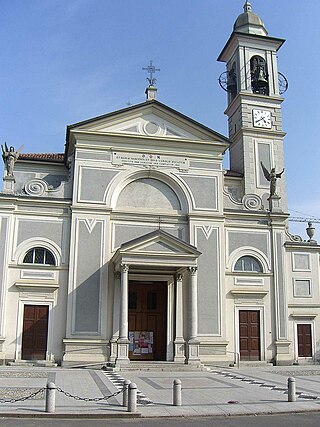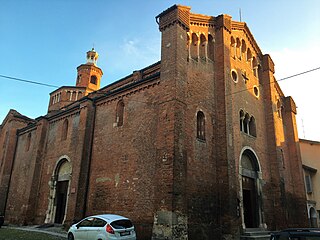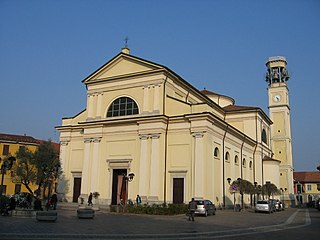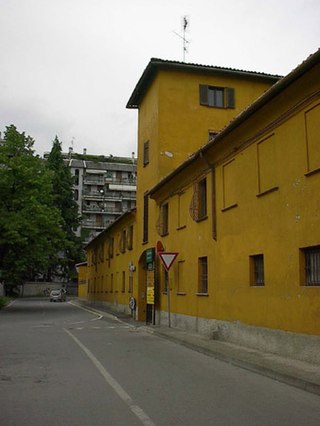
Brugherio is a comune (municipality) in the Province of Monza and Brianza in the Italian region Lombardy, located about 10 kilometres northeast of Milan. It was established December 9, 1866 unifying the suppressed municipalities of Baraggia, San Damiano and Moncucco, together with the villages of Bindellera, Cesena, Gelosa, San Paolo, Torazza, Occhiate and Increa.

San Damiano is a hamlet in far north Brugherio, Italy. It is located between the Milan-Bergamo highway and the eastern road ring of Monza. It is 1.46 kilometres (0.91 mi) away from the town center.

San Teodoro is a Romanesque-style Roman Catholic church in the town center of Pavia, Italy.
Villa Jacini is a large rural palace located on Via Conte Stefano Jacini the frazione of Zuccone Robasacco, within the town limits of Triuggio, Province of Monza and Brianza, region of Lombardy, Italy.

The Palazzo Ghirlanda-Silva is a patrician building in the old town of Brugherio, Italy. Built in the first half of the nineteenth century, it now houses the public library. It has an area of 1,992 m2 (21,440 sq ft), of which 1,407 m2 (15,140 sq ft) are used for library services, with the remaining space providing an exhibition room, an auditorium and offices.

The Church of Saint Bartholomew is the cathedral and the oldest parish in Brugherio, Italy. It houses relics of the three Magi. It is characterised by its relatively high bell tower measuring 36.8 metres (121 ft).

Saint Lucius in Brugherio, Italy, is a small church dedicated to Saint Lucius in the grounds of the Villa Sormani. First located in Lugano, Switzerland, where it was a Franciscan chapel, the building was disassembled and transported to Brugherio, where its reconstruction was completed 17 years later.

Villa Scotti-Cornaglia-Noseda-Bertani, commonly known as Villa Fiorita, is a building in Lombardy, Italy, where the Brugherio Comune's headquarters are housed.

Saint Ambrose is a small church which is an annex to the farmhouse that takes its name from it, in Brugherio, Italy.

The church of Saint Margaret is a 16th-century chapel dedicated to Saint Margaret of Antioch. It is located in Cassina Baraggia, Brugherio, Italy. The church is adjacent to the Villa Brivio, to which it belonged.

The Chiesetta di Sant'Anna, or Small Church of Saint Anne, is a Roman Catholic church located in San Damiano, a hamlet of Brugherio, in the Province of Monza and Brianza, Italy.

Cascina Increa is one of the farmhouses of Brugherio, on the southeastern border of the municipality. It enjoys the protection of the Soprintendenze per i Beni Architettonici e Paesaggistici, i.e., the Ministry of Cultural Heritage and Activities and Tourism (MiBACT) of its respective province because of its surviving Renaissance architecture.

Cascina Sant'Ambrogio is the oldest among the farmhouses in Brugherio, Italy. It is annexed to Saint Ambrose Church from which it takes its name.

Cassina Baraggia is a hamlet of Brugherio's municipality, which until 1866 was a separate municipality.

Moncucco was an autonomous Italian municipality until March 30, 1871, when due to a royal decree it became a hamlet of the town of Brugherio, established in 1866. The actual village is located south of Brugherio, along the road that leads from Milan to Vimercate.

There are three plague crosses in Brugherio, in the province of Monza and Brianza in Lombardy, in northern Italy. They were erected after the plague that struck Monza and its surrounding area in 1576. The crosses are three that remain of four that marked where there were four altars used to celebrate religious services during the plague. The plague of 1576 was in fact called "the plague of Saint Charles", given the Bishop's closeness to those affected. Information about the plague can be found in the Bishop of Milan, Saint Charles Borromeo's notes.

Villa Somaglia-Balconi is a residential complex located in Brugherio, consisting of a main house and some accompanying buildings, which are separated from the original structure of the villa by Via Marsala, which leads from Moncucco to Carugate.
The old farmhouses of Brugherio were agricultural structures typical of the Po-Valley in Lombardy, which gave its name to the surrounding areas as well, roughly corresponding to fractional towns in which Brugherio was divided. The union of the various small rural municipalities in which the territory was fragmented gave birth in 1866 to the municipality of Brugherio. Some are still visible: Bindellera, Casecca, Cattoni, Comolli, Dorderio, Guzzina, Increa, Modesta, Moia, Occhiate, Pareana, San Cristoforo, Sant'Ambrogio, San Paolo and Torazza.

Cascina Guzzina is a farmhouse located in the southern part of Brugherio, on the border with Cologno Monzese. The name comes from gussetta, which formerly referred to the cocoon of the silkworm, whose breeding was widespread in the area. Agricultural complexes known as "agricultural courts", which once held prolific agricultural activity, are now civilian residences and businesses.

The church of San Francesco of Assisi is a Catholic religious building in Pavia, Lombardy, Italy.


















